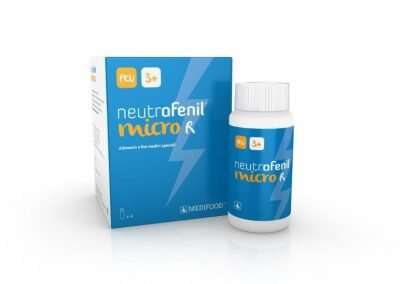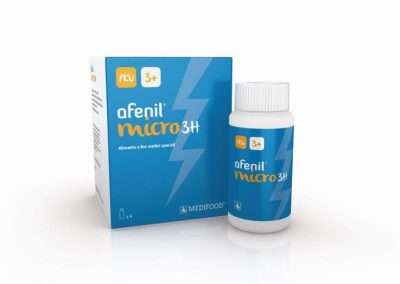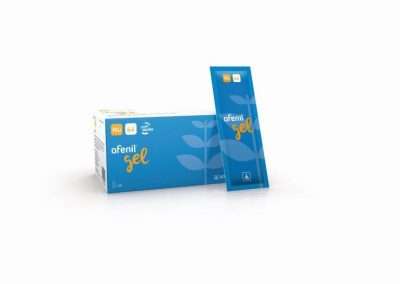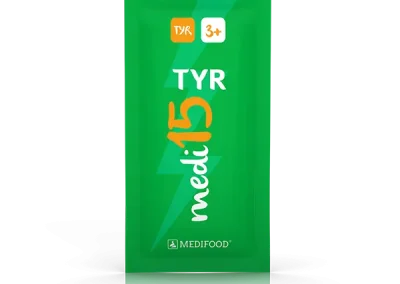Rare diseases & IEM products
 Glutaric Aciduria is an inherited metabolic disease that involves the metabolism of three amino acids: lysine, hydroxylisine and tryptophan. Amino acids are the constituent units of proteins and are therefore daily taken as part of one’s diet. Individuals with Glutaric Aciduria type 1 should be on a lysine-free and low-tryptophan diet. Given the impossibility of excluding these amino acids from natural proteins, the patient should, in general, follow a protein-free diet, supplemented with adequate protein substitutes (free from lysine and with a low tryptophan content). The treatment is, however, customized according to the needs of the individual patient.
Glutaric Aciduria is an inherited metabolic disease that involves the metabolism of three amino acids: lysine, hydroxylisine and tryptophan. Amino acids are the constituent units of proteins and are therefore daily taken as part of one’s diet. Individuals with Glutaric Aciduria type 1 should be on a lysine-free and low-tryptophan diet. Given the impossibility of excluding these amino acids from natural proteins, the patient should, in general, follow a protein-free diet, supplemented with adequate protein substitutes (free from lysine and with a low tryptophan content). The treatment is, however, customized according to the needs of the individual patient.
 Classical homocystinuria is an inherited metabolic disease characterized by the deficiency of an enzyme involved in the methyl metabolic pathway of the amino acid methionine. This deficiency leads to the accumulation of the amino acid homocysteine in the blood and urine. Amino acids are the constituent units of proteins and are therefore daily taken as part of one’s diet. Individuals with classic homocystinuria should follow a low-methionine diet.
Classical homocystinuria is an inherited metabolic disease characterized by the deficiency of an enzyme involved in the methyl metabolic pathway of the amino acid methionine. This deficiency leads to the accumulation of the amino acid homocysteine in the blood and urine. Amino acids are the constituent units of proteins and are therefore daily taken as part of one’s diet. Individuals with classic homocystinuria should follow a low-methionine diet.Given the impossibility of excluding this amino acid from natural proteins, the patient should, in general, follow a protein-free diet, supplemented with adequate protein substitutes (without methionine). The treatment is, however, customized according to the needs of the individual patient.
 Isovaleric Aciduria is an inherited metabolic disease related to the metabolism of the amino acid leucine.
Isovaleric Aciduria is an inherited metabolic disease related to the metabolism of the amino acid leucine.
Amino acids are the constituent units of proteins and are therefore daily taken as part of one’s diet. Individuals with Isovaleric Aciduria should follow a diet that does not contain the amino acid leucine, in order to minimize isovaleric acid formation.
Given the impossibility of excluding this amino acid from natural proteins, the patient, in general, should follow a protein-free diet, supplemented with adequate protein substitutes (without leucine).
 Methylmalonic Aciduria and Propionic Aciduria are hereditary metabolic diseases related to the metabolism of some amino acids. Amino acids are the constituent units of proteins and are therefore taken daily as part of one’s diet. Individuals with Methylmalonic or Propionic Aciduria should follow a diet free from the amino acids involved in the pathology (methionine, threonine and valine) and should also take a reduced amount of the amino acid isoleucine. Given the impossibility of excluding these amino acids from natural proteins, the patient should, in general, follow a protein-free diet, supplemented with adequate protein substitutes (not containing methionine, threonine and valine and with a low content of isoleucine). The treatment is, however, customized according to the individual patient’s protein needs.
Methylmalonic Aciduria and Propionic Aciduria are hereditary metabolic diseases related to the metabolism of some amino acids. Amino acids are the constituent units of proteins and are therefore taken daily as part of one’s diet. Individuals with Methylmalonic or Propionic Aciduria should follow a diet free from the amino acids involved in the pathology (methionine, threonine and valine) and should also take a reduced amount of the amino acid isoleucine. Given the impossibility of excluding these amino acids from natural proteins, the patient should, in general, follow a protein-free diet, supplemented with adequate protein substitutes (not containing methionine, threonine and valine and with a low content of isoleucine). The treatment is, however, customized according to the individual patient’s protein needs.
 MSUD is a hereditary metabolic disease, characterized by the inability of the individual affected to metabolize branched chain amino acids (leucine, isoleucine and valine).
MSUD is a hereditary metabolic disease, characterized by the inability of the individual affected to metabolize branched chain amino acids (leucine, isoleucine and valine).
Amino acids are the constituent units of proteins and are therefore daily taken as part of one’s diet. Individuals suffering from Leucinosis should follow a diet without amino acids which fail to metabolise (leucine, isoleucine and valine).
Given the impossibility of excluding these amino acids from natural proteins, the patient will, in general, have to follow a protein-free diet, supplemented with adequate protein substitutes (which do not contain leucine, isoleucine and valine).
 PKU is a condition characterized by the inability of the individual affected to metabolize the specific amino acid, phenylalanine. Amino acids are the constituent units of proteins and are taken daily in one’s diet. Persons affected by PKU should follow a phenylalanine-free diet, in order to avoid the appearance and progression of the symptomatic profile of this disease. Given the impossibility of excluding a specific amino acid from natural proteins used in food, the PKU patient should, in general, follow a protein-free diet and integrate it with adequate protein substitutes (i.e those not containing phenylalanine). The treatment is, however, customized according to the needs of the individual patient.
PKU is a condition characterized by the inability of the individual affected to metabolize the specific amino acid, phenylalanine. Amino acids are the constituent units of proteins and are taken daily in one’s diet. Persons affected by PKU should follow a phenylalanine-free diet, in order to avoid the appearance and progression of the symptomatic profile of this disease. Given the impossibility of excluding a specific amino acid from natural proteins used in food, the PKU patient should, in general, follow a protein-free diet and integrate it with adequate protein substitutes (i.e those not containing phenylalanine). The treatment is, however, customized according to the needs of the individual patient.
 Type 1 tyrosinemia is an inherited metabolic disease characterized by the inability of the individual affected to metabolize a specific amino acid, tyrosine. Amino acids are the constituent units of proteins and are therefore daily taken as part of one’s diet. Individuals with type 1 tyrosinemia should follow a diet that is free from tyrosine and another amino acid involved in the disease, phenylalanine, as a precursor to tyrosine. Given the impossibility of excluding these amino acids from natural proteins, the patient should, in general, follow a protein-free diet, supplemented with adequate protein substitutes (without tyrosine and phenylalanine). The treatment is, however, customized according to the needs of the individual patient.
Type 1 tyrosinemia is an inherited metabolic disease characterized by the inability of the individual affected to metabolize a specific amino acid, tyrosine. Amino acids are the constituent units of proteins and are therefore daily taken as part of one’s diet. Individuals with type 1 tyrosinemia should follow a diet that is free from tyrosine and another amino acid involved in the disease, phenylalanine, as a precursor to tyrosine. Given the impossibility of excluding these amino acids from natural proteins, the patient should, in general, follow a protein-free diet, supplemented with adequate protein substitutes (without tyrosine and phenylalanine). The treatment is, however, customized according to the needs of the individual patient.
 Urea Cycle Defects are a group of inherited metabolic diseases, characterized by deficiencies in enzymes and transporters involved in the urea cycle, a metabolic pathway dedicated to the transformation of ammonium (produced by the catabolism of amino acids) into urea, which in turn is eliminated from the body via urine. Some forms of UCD can be treated exclusively through restricting food proteins, in order to reduce the amount of ammonium deriving from their catabolism. However, a low-protein diet may not be able to provide the right amount of essential amino acids that the body needs; for this reason, the patient suffering from urea cycle defects should supplement a low-protein diet with a mix of essential amino acids. Moreover, in some cases it is necessary to intervene with a specific pharmacological treatment that supports the removal of ammonium.
Urea Cycle Defects are a group of inherited metabolic diseases, characterized by deficiencies in enzymes and transporters involved in the urea cycle, a metabolic pathway dedicated to the transformation of ammonium (produced by the catabolism of amino acids) into urea, which in turn is eliminated from the body via urine. Some forms of UCD can be treated exclusively through restricting food proteins, in order to reduce the amount of ammonium deriving from their catabolism. However, a low-protein diet may not be able to provide the right amount of essential amino acids that the body needs; for this reason, the patient suffering from urea cycle defects should supplement a low-protein diet with a mix of essential amino acids. Moreover, in some cases it is necessary to intervene with a specific pharmacological treatment that supports the removal of ammonium.
 Adrenoleukodystrophy (ALD) and adrenomyeloneuropathy (AMN) are two variants of a progressive disease that damages the nervous system. The disease is hereditary. “Adreno” refers to the adrenal glands, “leuko” means white and refers to the white substance (myelin) in the nervous system, and “dystrophy” means wasting away. In adrenomyeloneuropathy, “myelo” refers to the spinal cord, and “neuropathy” indicates that the disease affects the peripheral nerves.
Adrenoleukodystrophy (ALD) and adrenomyeloneuropathy (AMN) are two variants of a progressive disease that damages the nervous system. The disease is hereditary. “Adreno” refers to the adrenal glands, “leuko” means white and refers to the white substance (myelin) in the nervous system, and “dystrophy” means wasting away. In adrenomyeloneuropathy, “myelo” refers to the spinal cord, and “neuropathy” indicates that the disease affects the peripheral nerves.
































